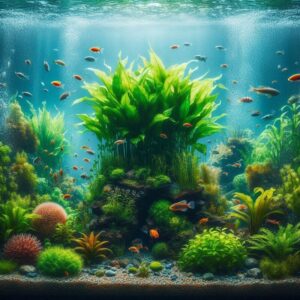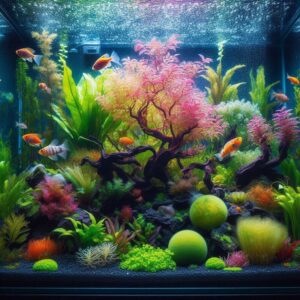Tips for Keeping Your Aquarium Plants Healthy and Beautiful
Aquarium plants may transform any fish tank into a visually appealing, vibrant underwater habitat. They create a visually pleasing backdrop while also boosting the overall health of your aquarium. Aquarium plants require regular care and maintenance to live and thrive. This comprehensive book will teach you everything you need to know about keeping aquarium plants healthy.
Understanding the Importance of Aquarium Plants
Before delving into the nuances of caring for aquarium plants, it’s important to understand why they’re such a good addition to your fish tank. Here are a few reasons why aquarium plants are important:
Oxygen Production: Aquarium plants’ photosynthesis emits oxygen into the air, improving water quality for fish and other marine life.
– Waste Absorption: Plants help to absorb excess nutrients, waste, and pollutants from water, such as ammonia, nitrates, and phosphates, reducing the risk of imbalances and preserving water quality.
– Natural Habitat: Aquarium plants offer refuge and hiding places for your fish, reducing stress and increasing general health.
– Algae Control: A well-planted tank prevents excessive algae growth by competing for nutrients and obstructing light.
Understanding these benefits will encourage you to develop the best maintenance regimen for your aquarium plants.

Choosing the Right Aquarium Plants
Choosing the right plants for your aquarium is critical to its success. Several variables must be considered.
Light Requirements:
Plants have varying light requirements, which are low, medium, and high. Understanding the lighting requirements of your chosen plants will enable you to provide the appropriate illumination. Tank Size: Consider the size and dimensions of your aquarium. Some plants may require taller or larger tanks, but others thrive in smaller spaces. Water parameters: Some plants prefer specific water conditions, such as temperature, pH, and hardness. Check the preferred specifications of your chosen plants to ensure they are suitable for your tank conditions.
Plants can develop slowly, steadily, or fast. Choose one that matches your preferences and is simple to manage.
Java Fern, Anubias, Amazon Sword, and Cryptocoryne are some of the most commonly recommended aquarium plants for beginners.
Creating a Suitable Environment for Your Aquarium Plants
Once you’ve determined which aquarium plants are best suited to your needs, providing them with an acceptable environment is necessary. Here’s how to create an optimal atmosphere for your plants:
Proper lighting is not a luxury; it is essential for the growth of your aquarium plants. Whether you use fluorescent, LED, or specialist plant lights, selecting the appropriate spectrum and intensity for your plants is critical. This ensures that they receive the light required for photosynthesis and growth. Remember not to overlook the importance of light in your aquarium habitat.
Water Circulation: Proper water circulation is essential for aquarium plants’ overall health and growth. Ensure filtration systems and water pumps are placed so nutrients flow and are appropriately distributed.
CO2 Injection: Carbon dioxide (CO2) injection is optional but extremely useful, particularly in high-light planted tanks. CO2 promotes robust plant development and prevents algae outbreaks. Several CO2 injection methods, including DIY yeast-based systems and pressurised CO2 setups, are available.
Maintaining Optimal Water Quality
The well-being of your aquarium plants depends on your diligent attention to water quality. Poor water quality can stunt plant growth and render plants vulnerable to various diseases. Here are some crucial points to consider:
Perform regular water changes to remove pollutants, extra nutrients, and contaminants. Ten to twenty per cent of the tank’s volume should be changed weekly.
Water Parameters: The stability and balance of water parameters are crucial for the health of your plants. Maintaining the recommended range for your plants’ needs is essential. Regular testing for pH, ammonia, nitrites, and nitrates is a proactive step towards a healthy aquatic environment for your plants.
Fertilisation: Certain plants may require additional fertilisation to thrive. Liquid fertilisers or root tabs can provide nitrogen, potassium, and phosphorus.
Algae Control: Proper plant care helps to control algae growth. Decaying or dying leaves should be removed soon to avoid excess nutrients and algae problems. Introduce algae-eating fish or prawns to help keep algae under check.
Pruning and Propagation Techniques
Aquarium plants require regular trimming and propagation to ensure good development and prevent overcrowding. Here are some pointers to bear in mind:
Trimming: It’s not just about removing dead or decaying leaves; it’s about managing the size and shape of your plants. This promotes bushier growth and keeps surrounding plants from being shaded, a key responsibility in plant care.
Many aquarium plants are easily propagated through division, stem cuttings, or runners. Investigate the propagation methods for your plant species to enlarge your collection or replant overgrown plants.
Plant placement: Consider their growth tendencies when arranging the plants in your tank. Leave enough space between plants to allow for growth and avoid overcrowding.

Troubleshooting Common Issues
You may need help caring for your aquarium plants despite your best efforts. Here are a few common problems and solutions:
Yellowing leaves can indicate a food deficit, insufficient illumination, or poor water quality. Adjust the fertiliser, lighting, and watering conditions accordingly.
Algae Overgrowth: If algae overgrow your aquarium plants, check the lighting duration and intensity, water parameters, and fertiliser levels. Adjust these parameters accordingly, and consider introducing algae-eating fish or invertebrates.
Melting Plants: Sudden plant melting frequently indicates insufficient acclimatisation, improper water conditions, or incompatible tankmates. Improve water quality and ensure compatibility with other occupants.
Pests and Diseases: Look for snails, aphids, and fungal infections. Quarantine and treat afflicted plants with aquarium-safe medicines, or seek professional assistance.
Most Popular Questions and Answers
How often should I fertilize my aquarium plants?
The frequency of fertilization depends on the nutrient requirements of your plants. While some plants may require regular fertilization, others can thrive with minimal supplementation. Monitor the growth and appearance of your plants to determine the required frequency.
Can I use regular soil for my aquarium plants?
Regular garden soil may contain additives or fertilizers that can harm your aquarium plants and impact water quality. It is best to use specialized aquatic soil or substrates specifically designed for aquarium use.
Do all aquarium plants require CO2 injection?
Not all aquarium plants require CO2 injection. Low- to moderate-light plants generally do well without additional CO2 supplementation. However, CO2 injection can significantly enhance growth and prevent algae outbreaks for high-light plants or demanding species.
Can I use tap water for my aquarium plants?
Tap water can be used for aquarium plants, but it is essential to remove chlorine and other harmful compounds. Treat tap water with a quality water conditioner, or let it sit for 24 hours before adding it to your aquarium.
How can I prevent algae growth in my aquarium plants?
Proper lighting, nutrient balance, and regular plant maintenance can help prevent excessive algae growth. Introducing algae-eating fish or invertebrates can also help keep algae under control.
Now, armed with the knowledge of how to care for and maintain your aquarium plants, you can create a stunning aquatic oasis that enhances the beauty of your fish tank and provides a healthy environment for your aquatic inhabitants. Your aquarium plants will flourish with proper care and attention, creating a captivating underwater landscape for years.
References
The Ultimate Care Guide For Betta Fish. https://aquaticbuddy.com/betta-fish/care/
Aquarium Thriving: Pro Tips For Long-Term Success. https://ourmarinespecies.com
The post How to Properly Care for and Maintain Your Aquarium Plants appeared first on Unity Pets.
The Article How to Properly Care for and Maintain Your Aquarium Plants Was Found On https://limitsofstrategy.com


